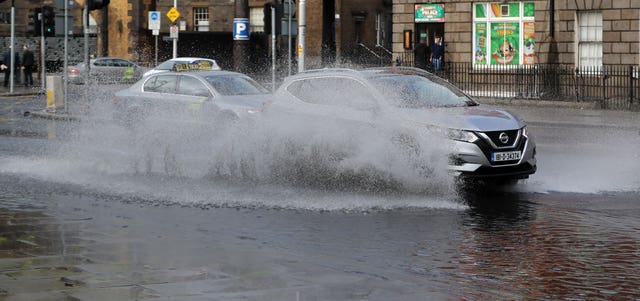
A storm named Diana has brought strong winds and heavy rain to parts of the UK as a number of flood warnings were issued for the South West.
The Met Office has issued yellow weather warnings for wind in western parts of the UK, from Cornwall up the coast to the far north of Scotland, as wind gusts of up to 75mph are expected on Wednesday.
Flooding is expected at Lyme Regis harbour and West Bay harbour in Dorset, the Environment Agency has warned, with flooding possible in other parts of the South West and Wales.
With strong winds in the forecast there are a few things you can do to prepare. Secure loose objects such as garden furniture, park your vehicle in a garage if possible. More advice
👉 https://t.co/SMbGZ4BrZr #WeatherReady pic.twitter.com/tjcriyHQxv
— Met Office (@metoffice) November 28, 2018
Met Office spokesman Richard Miles said the warnings are at the “lower end of the impact scale”, but advised people to be cautious in the conditions.
He said: “We have a yellow warning for wind in the west of the UK for today and tomorrow.
“There could be some risks for high-sided vehicles on high roads, and people should be careful in coastal areas.
“We’ve also got a yellow warning for rain in Scotland with quite high levels of rain in the area, and we could see 40-50mm of rain across the hills.”

Winds of 60mph are expected across western regions, but the strongest gusts are predicted in the far north of Scotland, with Shetland bracing for winds of up to 75mph through Wednesday and into Thursday.
Mr Miles added: “Anyone in the UK can expect to see wind and rain over the next few days.”
Diana is not on the list of the Met Office’s official storm names for this winter, and originated further south.
Mr Miles said the storm, named by the Portuguese authorities, “had quite an impact on islands in the Atlantic”, but had weakened as it travelled towards the UK.
He explained: “By the time it got to us it would not meet the criteria for us to name it.”
As well as disruption to transport, Thursday's strong winds could bring coastal impacts with large waves and rough seas 🌊🌬️ pic.twitter.com/1valP0qyYx
— Met Office (@metoffice) November 28, 2018
The last Met Office named storm was Callum, which battered parts of the UK in mid-October. The next name to be used will be Deirdre.
The AA have issued advice for drivers travelling in the wintry conditions.
George Flinton of the AA said: “Heavy rain and strong wind, coupled with commuting home in the dark, can make for some very hazardous driving conditions.
“Check the travel news before you set off and take particular care where roads dip, for example under railway bridges, which are more likely to flood.
“If the road ahead is flooded, don’t chance it – flood water can be deceptively deep, so turn around and find another route.”


Comments: Our rules
We want our comments to be a lively and valuable part of our community - a place where readers can debate and engage with the most important local issues. The ability to comment on our stories is a privilege, not a right, however, and that privilege may be withdrawn if it is abused or misused.
Please report any comments that break our rules.
Read the rules here